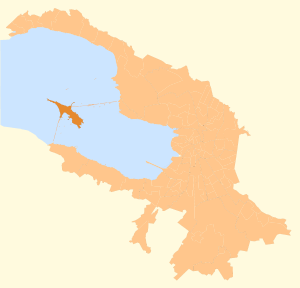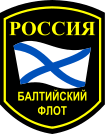Kronstadt
| Kronstadt (English) Кронштадт (Russian) | |
|---|---|
| - Municipal town - | |
|
| |
 Kronstadt | |
|
| |
 |
|
|
| |
| Administrative status | |
| Country | Russia |
| Federal subject | Saint Petersburg |
| Statistics | |
| Population (2010 Census) | 43,005 inhabitants[1] |
| Time zone | MSK (UTC+03:00)[2] |
| Founded | 1704 |
| Dialing code(s) | +7 812 |
|
| |
| Kronstadt on Wikimedia Commons | |
Kronstadt (Russian: Кроншта́дт), also spelled Kronshtadt, Cronstadt or Kronštádt (German: Krone for "crown" and Stadt for "city"; Finnish: Retusaari, Estonian: Kroonlinn), is a municipal town in Kronshtadtsky District of the federal city of Saint Petersburg, Russia, located on Kotlin Island, 30 kilometers (19 mi) west of Saint Petersburg proper near the head of the Gulf of Finland. Population: 43,005 (2010 Census);[1] 43,385 (2002 Census).[3]
It is also Saint Petersburg's main seaport. In March 1921, it was the site of the Kronstadt rebellion.
Traditionally, the seat of the Russian admiralty and the base of the Russian Baltic Fleet were located in Kronstadt guarding the approaches to Saint Petersburg. The historic centre of the city and its fortifications are part of the World Heritage Site Saint Petersburg and Related Groups of Monuments.
Kronstadt has been a place of pilgrimage for Orthodox Christians for many years due to the holy memory of Saint John of Kronstadt. Bus and water tours to Kronstadt are taken daily from Saint Petersburg.[4]
Kronstadt was the birthplace of Pyotr Kapitsa, co-recipient of the 1978 Nobel Prize in Physics.
History




Kronstadt was founded by Peter the Great, who took the island of Kotlin from the Swedes in 1703. The first fortifications were inaugurated on May 18, 1704.
These fortifications, known as Kronstadt's Forts, were constructed very quickly. During the winter the Gulf of Finland freezes completely. Workers used thousands of frames made of oak logs filled with stones. These were carried by horses across the frozen sea, and placed in cuttings made in the ice. Thus, several new small islands were created, and forts were erected on them, closing all access to Saint-Petersburg by the sea. Only two narrow navigable channels remained, and the strongest forts guarded them.
Kronstadt was thoroughly refortified in the 19th century. The old three-decker forts, five in number, which formerly constituted the principal defences of the place, and defied the Anglo-French fleets during the Crimean War, became of secondary importance. From the plans of Eduard Totleben a new fort, Constantine, and four batteries were constructed (1856–1871) to defend the principal approach, and seven batteries to cover the shallower northern channel. All these fortifications were low and thickly armored earthworks, powerfully armed with heavy Krupp guns in turrets. The town itself is surrounded with an enceinte.
In summer 1891, the French fleet was officially—and triumphantly—received in Kronstadt. It was a first step towards the coming Franco-Russian Alliance.
Russian Civil War
During the Petrograd (now Saint Petersburg) riots of the February revolution, the sailors of Petrograd joined the revolution and executed their officers, thus gaining a reputation as dedicated revolutionaries. During the civil war, the sailors participated on the red side, until 1921, when they rebelled against the Bolshevik rule.
Kronstadt and the supporting forts and minefields were the key to the protection of Petrograd from foreign forces. Despite this, the cruiser Oleg was torpedoed and sunk by a small motor boat after participating in a bombardment of Krasnaya Gorka fort that had revolted against the Bolsheviks.[5] This was followed on August 18, 1919, by a raid of seven Royal Navy Coastal Motor Boats into the harbor of Kronstadt itself, damaging the Soviet battleships Petropavlovsk and Andrei Pervozvanny, and sinking a submarine supply ship, the Pamiat Azova.
Kronstadt Rebellion
In 1921, a group of navy officers and sailors, soldiers as well as their civilian supporters rebelled against the Bolshevik government in Soviet Kronstadt. The garrison had previously been a centre of major support for the Bolsheviks, and throughout the Civil War of 1917–1921, the navy of Kronstadt had been at the vanguard of the main Bolshevik attacks. Their demands included "freedom of speech", a stop to the deportation to work camps, a change in Soviet war politics, and liberation of the soviets (workers' councils) from "party control".[6] After brief negotiations, Leon Trotsky (then the Minister of War in the Soviet Government, and the leader of the Red Army) responded by sending the army to Kronstadt, along with the Cheka. The uprising was thus suppressed.
World War II
In the late 1930s, Kronstadt lived the life of the fortified city and was the base of the Baltic Fleet. During that time Kronstadt was an important training center of the Soviet Navy. The Kronstadt Ship Repair Plant (Navy Plant) overhauled and repaired surface ships and submarines of the Baltic Fleet. All forts and batteries of the city were under reconstruction.
At 23:37 on June 21, 1941, the operational readiness of Fleet Number 1 was announced by Baltic Fleet Commander Vice Admiral V. Tributs according to the order of the People's Commissar of the Navy. Several hours later the first German aircraft began mining the fairway near Kronstadt. The duty officer (First Lieutenant S. Kushnerev) ordered antiaircraft batteries to open fire on the enemy planes; several aircraft were shot down or damaged. Twenty-seven German planes took part at the first attack, and three of them were destroyed by the anti-aircraft guns of the 1st Air Defence Regiment of the Baltic Fleet. This regiment was situated on the southern forts.
During World War II, Kronstadt was bombed several times by the Luftwaffe. In August 1941 the Luftwaffe began bombing Kronstadt regularly. The most notable bombing was Stuka ace Hans-Ulrich Rudel's sinking of the Soviet battleship Marat.
To prevent an enemy landing, 13 artillery batteries were established in Kronstadt and nine more batteries beyond the city, (but on the island Kotlin). The main lookout was located in the Naval Cathedral. Visual range reached 45 km (28 mi). The coastal defense of Kronstadt included two infantry regiments.
In late August, the Red Army in the Baltic States was in a critical situation. Tallinn, the main base of the fleet, was in danger and a decree to relocate the fleet from Tallinn to Kronstadt was given. By the time the Soviets had decided on a maritime evacuation of Tallinn, over 200 Soviet civilian and military vessels had been assembled in the harbor of Tallinn.
After the evacuation of Tallinn, the submarine subdivision had been organized in Kronstadt. By the end of 1941, 82 naval operations were made. Hitler was enraged, because Soviet submarines frequently disrupted military supplies of strategic materials from Sweden to Germany. The Germans tried to block completely the exit from the Gulf of Finland with antisubmarine nets and mines. Despite these efforts, the Soviet submariners continued to attack German ships. In 1942, 29 German vessels were sunk. Submarines cooperated with reconnaissance aircraft in searching for military targets.
But the Soviet submarines had broken through the mine barrages in the Gulf of Finland easily in 1942. To keep the Soviet submarine force away from the Baltic shipping stronger efforts were planned. The minefields would be larger and in addition a double submarine net would be laid from Porkkala to Naissaari, Operation "Walross". The blocking of the Gulf of Finland had been a 100% effective anti-submarine operation. But in 1944, when Finland was defeated and provided several bases to the Soviet Navy, the submarine warfare in the Baltic Sea reached a new and final stage.
The Baltic Fleet sent more than 125,000 people to serve ashore at the front. Eighty-three thousand people fought directly on the Leningrad Front. For the protection of Leningrad 10 brigades of marines, four regiments, and more than 40 separate battalions and companies were formed in Kronstadt.
The Luftwaffe and German artillery brought down thousands of bombs and shells to the Naval Plant and the Arsenal factory. The German air raids in September 1941, damaged the Baltic Fleet ships and infrastructure of the Plant. Several sections of the Plant were destroyed, the docks were showered with falling bombs, and dozens of workers and engineers were killed. Nevertheless, the plant continued its work. In the difficult conditions of the siege, the workers persevered with their work. Often the working day lasted for 18–20 hours.
It was thanks to the power of the Kronstadt Fortress that the destruction of Leningrad (the main industrial and cultural center of the Soviet Union) was successfully prevented. Kronstadt was conferred the status of "City of Military Glory" by the President of the Russian Federation Dmitriy Medvedev on April 27, 2009, for "courage, endurance and mass heroism, exhibited by defenders of the city in the struggle for the freedom and independence of the Motherland".
Main sights

The town of Kronstadt is built on level ground and is thus exposed to flooding, most notably in 1824. On the south side of the town there are three harbors: the large western or merchant harbor, the western flank of which is formed by a great mole joining the fortifications which traverse the breadth of the island on this side; the middle harbor, used chiefly for fitting out and repairing vessels; and the eastern or war harbor for vessels of the Russian Navy. The Peter and Catherine Canals, connecting with the merchant and middle harbours, traverse the town. Between them stood the old Italian palace of Prince Menshikov, the site of which was later occupied by a pilot school. In the second half of the 18th century the building of former Italian palace began to be used for various military training institutions. In 1771–1798 the Sea Cadet Corps were housed here. The Cadet Corps was transferred to St Petersburg and from 1798 to 1872 the Navigating School was situated in the former palace.
Near with the former Italian palace the Kronstadt sea-gauge is situated. Sea level observations began in Saint Petersburg in 1703. On Kotlin Island, with main naval fortress of the Russian Empire, it began in 1707. This monitoring was necessary because level of the Finnish Gulf could change considerably in a short time, creating problems for shipping. The annual flood also required close monitoring of the water level. The Kronstadt sea-gauge with the tide gauge pavilion is the zero level of the Baltic system of depths and heights. All depths and altitudes (even the heights of spacecraft) in Russia and some other countries (former Russian Empire) are measured from the level of Kronstadt sea gauge. Yuri Gagarin, the first man in space, ironically said in 1967 that this is it the Hub of the Universe.
The modern town's most striking landmark is the enormous Naval Cathedral, built from 1908 to 1913 and considered to represent a culmination of Russian Neo-Byzantine architecture. The older St Andrew Cathedral (1817), formerly Kronstadt's pride and beauty, was destroyed on Communist orders in 1932. St John of Kronstadt, one of the most venerated Russian saints, served there as a priest from 1855 to 1908.

Among other public buildings are the Naval Hospital, the British Seamen's Hospital (established in 1867), the Civic Hospital, the Admiralty (founded 1785), the arsenal, dockyards and foundries, the School of Marine Engineering, and the English Church. The port is ice-bound for 140–160 days in the year, from the beginning of December to April. A very large proportion of the inhabitants are sailors.
The Kronstadt Sea Fortress was considered the most fortified port in the world. Kronstadt still retains some of the "forts", small fortified artificial islands. Formerly, there were 22 such forts, situated in line between the southern and northern shores of the Gulf of Finland. Some fortifications were located inside the city itself and one was on the western shore of the Kronslot Island (on the other side of the main navigational channel).
Nowadays, the construction of the Saint Petersburg Dam has led to some of the forts being demolished. The dam also permitted Kronstadt and some of the forts to be reached without using a boat. Among the most important surviving forts are Fort Konstantin, the biggest in the Gulf of Finland; Fort Rif on the western shore of the island; and the particularly well-preserved Fort Alexander I (Plague Fort). The largest and the newest of the forts, built at the beginning of the 20th century, is Fort Totleben, named after Eduard Totleben.
International relations
Twin towns and sister cities
Kronstadt is twinned with:
References
- 1 2 Russian Federal State Statistics Service (2011). "Всероссийская перепись населения 2010 года. Том 1" [2010 All-Russian Population Census, vol. 1]. Всероссийская перепись населения 2010 года (2010 All-Russia Population Census) (in Russian). Federal State Statistics Service. Retrieved June 29, 2012.
- ↑ Правительство Российской Федерации. Федеральный закон №107-ФЗ от 3 июня 2011 г. «Об исчислении времени», в ред. Федерального закона №271-ФЗ от 03 июля 2016 г. «О внесении изменений в Федеральный закон "Об исчислении времени"». Вступил в силу по истечении шестидесяти дней после дня официального опубликования (6 августа 2011 г.). Опубликован: "Российская газета", №120, 6 июня 2011 г. (Government of the Russian Federation. Federal Law #107-FZ of June 31, 2011 On Calculating Time, as amended by the Federal Law #271-FZ of July 03, 2016 On Amending Federal Law "On Calculating Time". Effective as of after sixty days following the day of the official publication.).
- ↑ Russian Federal State Statistics Service (May 21, 2004). "Численность населения России, субъектов Российской Федерации в составе федеральных округов, районов, городских поселений, сельских населённых пунктов – районных центров и сельских населённых пунктов с населением 3 тысячи и более человек" [Population of Russia, Its Federal Districts, Federal Subjects, Districts, Urban Localities, Rural Localities—Administrative Centers, and Rural Localities with Population of Over 3,000] (XLS). Всероссийская перепись населения 2002 года [All-Russia Population Census of 2002] (in Russian). Retrieved August 9, 2014.
- ↑ "Boat tour to Kronstadt".
- ↑ Ingrian nationalists, according to Operation Kronstadt
- ↑ http://web.jjay.cuny.edu/~jobrien/reference/ob19.html
- ↑ Hassinen, Raino. "Kotka - International co-operation: Twin Cities". City of Kotka. Retrieved 2013-10-22.
-
 This article incorporates text from a publication now in the public domain: Chisholm, Hugh, ed. (1911). "article name needed". Encyclopædia Britannica (11th ed.). Cambridge University Press.
This article incorporates text from a publication now in the public domain: Chisholm, Hugh, ed. (1911). "article name needed". Encyclopædia Britannica (11th ed.). Cambridge University Press.
External links
| Wikivoyage has a travel guide for Kronstadt. |
- Kronstadt history
- Kronstadt web site
- Map of Kronstadt
- Kronstadt: Virtual Excursion
- International Kronstadt Development Fund
- Visit Kronstadt Naval Cathedral in 60 seconds
- Kronstadt Fortress (city fortifications)



